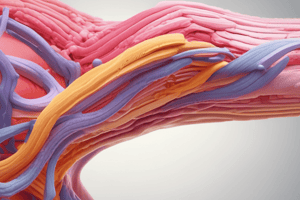Podcast
Questions and Answers
During the relaxation phase of muscle contraction, what happens to the actin filaments?
During the relaxation phase of muscle contraction, what happens to the actin filaments?
- They overlap one another
- They extend from two successive Z discs
- They barely overlap one another (correct)
- They shorten
What is the maximum strength of tetanic contraction of a muscle operating at a normal muscle length?
What is the maximum strength of tetanic contraction of a muscle operating at a normal muscle length?
- 7-8 kg/cm²
- 1-2 kg/cm²
- 5-6 kg/cm²
- 3-4 kg/cm² (correct)
What is treppe, also known as the 'staircase effect'?
What is treppe, also known as the 'staircase effect'?
- The decrease in muscle strength at the onset of contraction
- The increase in muscle strength at the onset of contraction (correct)
- The decrease in muscle strength during relaxation
- The plateau in muscle strength during contraction
What occurs after the first five stimuli during temporal summation?
What occurs after the first five stimuli during temporal summation?
What are some factors that contribute to muscle fatigue?
What are some factors that contribute to muscle fatigue?
What happens to the forcefulness of muscle contraction depending on the length of the sarcomeres within a muscle?
What happens to the forcefulness of muscle contraction depending on the length of the sarcomeres within a muscle?
Which type of motor units are recruited first during a muscle contraction?
Which type of motor units are recruited first during a muscle contraction?
What is the purpose of the size principle of motor unit recruitment?
What is the purpose of the size principle of motor unit recruitment?
What happens to muscle tone when a nerve is damaged?
What happens to muscle tone when a nerve is damaged?
What occurs during the latent phase of muscle twitch?
What occurs during the latent phase of muscle twitch?
What is the mechanism of tetanization?
What is the mechanism of tetanization?
How does frequency summation contribute to muscle contraction?
How does frequency summation contribute to muscle contraction?
Which type of muscle fiber arrangement has a parallel fiber arrangement and is capable of greater range of motion?
Which type of muscle fiber arrangement has a parallel fiber arrangement and is capable of greater range of motion?
Which type of muscle fiber arrangement has an oblique arrangement resembling that found in a feather?
Which type of muscle fiber arrangement has an oblique arrangement resembling that found in a feather?
Which type of muscle is responsible for mobility (rotatory) and has its proximal attachment far from the joint axis?
Which type of muscle is responsible for mobility (rotatory) and has its proximal attachment far from the joint axis?
Which type of muscle fiber has a high proportion of FG fibers and is located superficially?
Which type of muscle fiber has a high proportion of FG fibers and is located superficially?
Which architectural characteristic directly determines the amount of shortening or lengthening of a muscle fiber?
Which architectural characteristic directly determines the amount of shortening or lengthening of a muscle fiber?
What is the measure of the cross-sectional area of a muscle perpendicular to the orientation of the muscle fibers?
What is the measure of the cross-sectional area of a muscle perpendicular to the orientation of the muscle fibers?
Which of the following factors can affect muscle strength?
Which of the following factors can affect muscle strength?
In a first-class lever, where are the two resultant forces applied?
In a first-class lever, where are the two resultant forces applied?
Which lever class has the moving force closer to the axis than the weight or resistance?
Which lever class has the moving force closer to the axis than the weight or resistance?
What is the formula for mechanical advantage in a lever system?
What is the formula for mechanical advantage in a lever system?
Which lever class provides a force advantage so that large things can be moved by a small force?
Which lever class provides a force advantage so that large things can be moved by a small force?
What is an example of a second-class lever in the human body?
What is an example of a second-class lever in the human body?
Which of the following is true about tension in an unstretched muscle that is stimulated?
Which of the following is true about tension in an unstretched muscle that is stimulated?
Which of the following is true about tension in a moderately stretched muscle that is stimulated?
Which of the following is true about tension in a moderately stretched muscle that is stimulated?
Which of the following is true about tension in an overstretched muscle that is stimulated?
Which of the following is true about tension in an overstretched muscle that is stimulated?
Which of the following is true about isotonic contraction?
Which of the following is true about isotonic contraction?
Which of the following is true about hypertrophy?
Which of the following is true about hypertrophy?
Which of the following is true about atrophy?
Which of the following is true about atrophy?
Flashcards are hidden until you start studying
Study Notes
Muscle Contraction
- During relaxation phase, actin filaments slide back to their original position.
- Maximum strength of tetanic contraction of a muscle operating at a normal muscle length is 4-5 times the maximum strength of a single twitch.
Muscle Physiology
- Treppe, also known as the 'staircase effect', is a gradual increase in muscle contraction force due to repeated stimulation.
- After the first five stimuli during temporal summation, the muscle contraction force increases.
- Factors that contribute to muscle fatigue include depletion of ATP and CP, increase in lactic acid, and decrease in pH.
Muscle Mechanics
- Forcefulness of muscle contraction depends on the length of the sarcomeres within a muscle, with optimal force generated at resting length.
- Slow-twitch motor units are recruited first during a muscle contraction.
- The size principle of motor unit recruitment ensures that the smallest motor units are recruited first to achieve precise movements.
- When a nerve is damaged, muscle tone decreases.
Muscle Twitch
- During the latent phase of muscle twitch, there is a delay between the stimulation and the contraction of the muscle.
- Mechanism of tetanization involves the rapid stimulation of a muscle, resulting in the summation of individual muscle twitches.
Muscle Fibers
- Frequency summation contributes to muscle contraction by increasing the force of contraction through rapid stimulation.
- Parallel fiber arrangement is found in muscles capable of greater range of motion.
- Oblique fiber arrangement, resembling that found in a feather, is found in muscles with a complex architecture.
- Rotatory muscles, responsible for mobility, have their proximal attachment far from the joint axis.
- Superficial muscles with a high proportion of FG fibers have a high proportion of fast-twitch fibers.
Muscle Architecture
- The amount of shortening or lengthening of a muscle fiber is directly determined by its architectural characteristic.
- Cross-sectional area of a muscle perpendicular to the orientation of the muscle fibers is known as the physiological cross-sectional area (PCSA).
Muscle Strength
- Factors that can affect muscle strength include muscle length, muscle fiber type, and neural drive.
- In a first-class lever, the two resultant forces are applied on either side of the fulcrum.
- Second-class lever has the moving force closer to the axis than the weight or resistance, providing a force advantage.
- The formula for mechanical advantage in a lever system is output force / input force = distance of effort arm / distance of resistance arm.
- Third-class lever provides a force advantage, allowing large things to be moved by a small force.
- An example of a second-class lever in the human body is the wheelbarrow-like movement of the foot during plantarflexion.
Muscle Tension
- In an unstretched muscle that is stimulated, tension increases rapidly to a maximum and then plateaus.
- In a moderately stretched muscle that is stimulated, tension increases to a maximum and then decreases as the muscle shortens.
- In an overstretched muscle that is stimulated, tension is minimal due to the decreased overlap of actin and myosin filaments.
- Isotonic contraction is a type of muscle contraction where the muscle shortens while generating a constant tension.
- Hypertrophy occurs when muscle fibers increase in size, leading to an increase in muscle strength.
- Atrophy occurs when muscle fibers decrease in size, leading to a decrease in muscle strength.
Studying That Suits You
Use AI to generate personalized quizzes and flashcards to suit your learning preferences.




